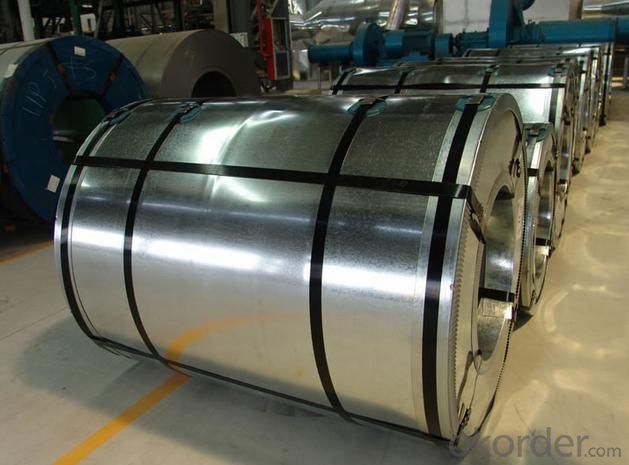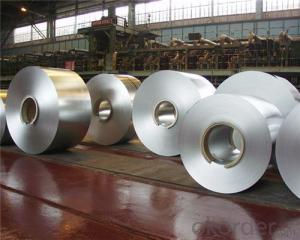Hot Dipped Galvanized Steel Coil for Construction and Cold RollingForming
- Loading Port:
- Shanghai
- Payment Terms:
- TT OR LC
- Min Order Qty:
- 30 m.t.
- Supply Capability:
- 10000 m.t./month
OKorder Service Pledge
OKorder Financial Service
You Might Also Like
Basic Info.
Model NO.:GT00818
Surface Treatment:Galvanized
Additional Info.
Packing:At buyer′s requirement
Standard:GB,JIS,ASTM
Origin:CHINA
HS Code:72123000
Production Capacity:50,000 mt/year
Product Description
Commodity: Hot dipped galvanized steel coil
Size: Thickness: 0.20mm to 1.2mm; Width: 500mm to 820mm
Surface finish: Regular spangle; Small spangle
Surface treatment: Chromated passivation
Zinc coating: Z08, Z12, Z18
Packing: Mill's standard packing for exporting
Usage: used in the industries such as construction ,cold rolling forming and electro mechanics manufacturing, household electric appliance manufacturing and etc
Standard adopted: GB/T2518-1998;Also we supply such steel strips according to JIS,ASTM standard to meet users'requirements.
Steel grade: Q195,Q195L,SPCC(Other material require agreement )
Equivalent standard: JIS G3302 1998 or ASTM A653M/A924M 1998
Price Terms: FOB, CIF Term
Payment Terms: T/T, L/C at sight
Delivery: 15 days after receiving your valid L/C/down payment
- Q: What is the yield strength of steel coils?
- The yield strength of steel coils can vary depending on the specific type and grade of steel being used. However, in general, the yield strength of steel coils typically ranges from 30,000 to 100,000 pounds per square inch (psi).
- Q: I'm looking for a steel plate for an design project that requires neodymium magnets to be stuck on them. I am trying to figure out what kind of steel plate would have hold the magnets up the best.
- Magnet
- Q: For the purpose of blade crafting. I need to heat treat this low quality steel i got.It's ASTM A36Is heat treatable and temperable?
- A36 is plain carbon structural steel. A36 could almost be considered junk steel. It is not suitable for cutting tools in any respect, as it is far to soft to hold an edge. A36 generally cannot be heat-treated, A36 can only be strengthened by cold-working, and even then, only up to about 60,000 psi. Heating the steel will only make it softer. The only real virtue of A36 is that it's easy to work with, it's easily cut and machined and it is very easy to weld. This is good for making steel structure, but not for knives. Probably the most popular material for knife blades is type 440C stainless. 440C is easy to work with in the un-treated state, and the heat treatment procedure is relatively simple.
- Q: How are steel coils protected from chemical damage?
- Steel coils are typically protected from chemical damage through various methods such as applying protective coatings or using barrier films. These protective measures act as a barrier between the steel surface and any potentially corrosive chemicals, preventing direct contact and minimizing the risk of chemical damage.
- Q: What is the major disadvantage of hardened steel? Do you think this form of iron would be wear resistant and retain a sharpened edge?
- The major disadvantage of hardened steel is that it is very brittle unless it is tempered. Hardened steel would be wear resistant, and would hold an edge as long as you don't cut anything harder than a boiled egg - the impact of the knife on a cutting board would shatter it.
- Q: How are steel coils packaged for shipment?
- Steel coils are typically packaged for shipment by being tightly wound, strapped with steel bands, and then secured onto wooden pallets. The coils are often covered with protective wrapping or placed inside steel containers to ensure safe transportation and prevent damage or corrosion.
- Q: How do steel coil manufacturers meet customer specifications?
- Steel coil manufacturers meet customer specifications by carefully analyzing the requirements provided by the customer and utilizing advanced production techniques to ensure precise dimensions, mechanical properties, and surface finishes. They employ strict quality control measures throughout the manufacturing process, including rigorous testing and inspections, to ensure that the coils meet the specified standards. Additionally, manufacturers often collaborate closely with customers to understand their unique needs and provide customized solutions that meet or exceed their expectations.
- Q: How do steel coils contribute to strength and durability in manufacturing?
- Steel coils contribute to strength and durability in manufacturing primarily due to their composition and structural properties. The tightly wound coils are made from high-quality steel, which offers excellent strength, rigidity, and resilience. This enables manufacturers to produce sturdy and long-lasting products, as the steel coils provide a solid foundation and structural integrity to various applications. Additionally, steel coils are often used in the construction of infrastructure, machinery, and automotive industries, where their durability and resistance to wear and tear play a vital role in ensuring the longevity and reliability of the final product.
- Q: What are the different methods of coil handling and storage?
- The different methods of coil handling and storage include using coil racks, coil cradles, coil cars, coil tongs, and coil lifters. Additionally, coil handling can be done manually or with the use of automated systems such as coil transfer cars and overhead cranes. It is important to consider factors such as coil size, weight, and material when determining the appropriate method for handling and storing coils.
- Q: With the Reduced weight of steel,wouldn't the projectile be at a much higher velocity when fired causing more damage?I mean l couldn't steel be worked to seal the bore,not damage the rifling and still cheap enough to mass produce,and be light enough to carry much more ammo.
- Okay one side note before going into the main issue. Steel is really really hard on rifle barrels. Okay, so the most common lead 9mm bullet weighs 124 grains. If all that was wanted was higher velocity, you could switch to a 115 grain bullet (which some people do), or even a 90 grain bullet if you are a reloader. (You see 90 grain bullets for 380 acp ammo, that same bullet could be reloaded onto a 9mm cartridge) But velocity alone doesn't give power. That's why a 115 grain 9mm bullet going at it's standard velocity does less damage than a 45 acp's 230 grain bullet going at it's standard velocity, because it weights twice as much and yet is going only a little bit slower But now go out to your front yard and grab a ping-pong ball and a rock about the same size. Throw them both as hard as you can. The ping-pong ball while lighter didn't go very far did it. See, the ratio of surface area to overall weight of ping-pong ball is very high, so air resistance works on it a LOT. And that is what makes lead so great for projectiles. It is dense so you have a very small surface area per unit of weight meaning that a steel bullet may beat lead in initial velocity but just 50 feet out the lead bullet would be going pretty much the same speed and at 100 yards out the steel would be dramatically slower. Note this is the same reason why 'secret sniper ice bullets' would never work even if you could get it to not melt...it's just too light. Ever hear of tanks and airplanes firing DU ammo? That stands for Depleted Uranium, it is something that is even more dense than lead which is why it makes an even better bullet than lead
Send your message to us
Hot Dipped Galvanized Steel Coil for Construction and Cold RollingForming
- Loading Port:
- Shanghai
- Payment Terms:
- TT OR LC
- Min Order Qty:
- 30 m.t.
- Supply Capability:
- 10000 m.t./month
OKorder Service Pledge
OKorder Financial Service
Similar products
Hot products
Hot Searches
Related keywords





























